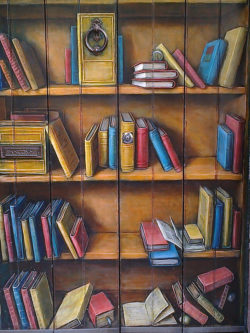If you are tired of taking acquisition adventures from librarian and bookseller memoirs as proof of the larger trends at play within the literary archives market, this is the book for you. Chen’s pithy study takes us through the views of each stakeholder connected to a typical American literary archival collection, from creator to end user, mainly through both quantitative and qualitative examples using her meticulous dataset of those authors included in the seventh edition of The Norton Anthology of American Literature (hereafter NAAL).
Heather G. Cole and R.W.G. Vail. Theodore Roosevelt: A Descriptive Bibliography .
Heather G. Cole is the Head of Special Collections Instruction and Curator of Literary and Popular Culture Collections at Brown University’s John Hay Library; from 2012 to 2017 she was the Curator of the Theodore Roosevelt Collection at Harvard University. She has continued the work done by R.W.G. (Robert William Glenroie) Vail. He was the Librarian at the museum created by the Roosevelt Memorial Association, after Roosevelt’s death, on the site of his childhood home on 20th Street Manhattan (today the Theodore Roosevelt Birthplace National Historic Site). Vail had first started putting together as many documents on Roosevelt as possible. Later, he decided to begin writing a bibliography of all of Roosevelt’s works. During the 1920s, he wrote to publishers, collaborators and booksellers to find out as much as he could on these works. He could not complete and publish the bibliography, he started working for the New York Public Library in 1937. His work was “recovered” by Heather Cole and brought back to life; what she managed to do was to make all the work previously done, plus new information and research, available to readers and researchers.
SHARP, BSA, BSANZ and the place of Book History
Periodically, SHARP News will publish reflections from members of SHARP’s Executive Council regarding the state of the field and ongoing developments of the society. Our president, Shef Rogers, writes this section’s inaugural post.
Special Topics Bibliographies: Africa
In addition to our annual bibliographies, SHARP News will now also publish bibliographies focused on specific regions or on specific areas of study. We welcome any suggestions for future topics! Our inaugural post offers a select bibliography on Africa and Africana Studies. Compiled by Cecile Jagodzinski.
Despoix, Philippe, and Jillian Tomm, eds. Raymond Klibansky and the Warburg Library Network: Intellectual Peregrinations from Hamburg to London and Montreal.
This collaborative book uses Raymond Klibansky as a window through which the reader can become acquainted with the agents and circumstances the philosopher encountered and navigated throughout his life. Although the book demonsrates how Klibansky was the result of his context, it is also clear that his intellectual journey, his philosophical and philological enterprises, and his rigorous commitment to knowledge changed the intellectual landscapes of Art History, Medieval Studies, and Philosophy. The title accurately depicts the focus of the book; a discussion of Klibansky that does not acknowledge the network surrounding the Warburg Library is not possible, just as an attempt to revise the history of The Warburg Institute without mention of Klibansky’s contributions would be unimaginable.





